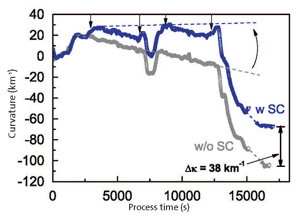- News
19 December 2013
LayTec's EpiCurve TT used for strain engineering of GaAs-based laser structures
It is known that metal-organic vapor phase epitaxy (MOVPE) growth of AlGaAs on GaAs is limited by lattice mismatch at room temperature and not at growth temperature (A. Maassdorf et.al., J. Cryst. Growth 370 (2013) 150-153), notes in-situ metrology system maker LayTec AG of Berlin, Germany. The resulting wafer bow may cause problems during the subsequent processing and chip mounting of edge-emitting laser diodes.
In order to reduce the wafer bow at room temperature, Dr Andre Maaßdorf and his team at Ferdinand-Braun-Institut (FBH) in Berlin, Germany, have developed a special scheme for strain engineering: they add phosphorus (P) and replace Al0.85GaAs by Al0.85GaAs0.96P in a distributed manner.
To control their laser growth in an Aixtron MOCVD system in real-time, the team uses LayTec’s EpiCurve TT for simultaneous curvature, pyrometry and reflectance measurements to observe the curvature development, the temperature and the layer thickness.
 Picture:
In-situ curvature data of laser structure with (blue) and without (grey) SC layers (marked by arrows). Dashed lines show envelopes of the curvature in both cases (A. Maassdorf et.al., J. Cryst. Growth 370 (2013) 150-153).
Picture:
In-situ curvature data of laser structure with (blue) and without (grey) SC layers (marked by arrows). Dashed lines show envelopes of the curvature in both cases (A. Maassdorf et.al., J. Cryst. Growth 370 (2013) 150-153).
The Figure shows two curvature transients of an edge-emitting laser structure with and without strain-compensating (SC) AlGaAsP layers (indicated by vertical arrows). These layers directly replace AlGaAs and have a thickness of 230–350nm.
The dashed lines show the curvature envelopes of both transients. The envelope for the non-compensated structure is tilted (grey dashed line), which leads to an increased convex bow throughout growth, but the envelope of the compensated structure is flat (blue dashed line).
Furthermore, it can be seen that compressive strain occurring during cool down (after ~1250s) remains the same in both cases, as it is caused by the differing thermal expansion of the layer and substrate. However, the final room-temperature curvature of the compensated structure is reduced by 38km-1 (see Figure).
Finally (in A. Maaßdorf et al., J. Appl. Phys. 114 (2013), 033501), Maaßdorf has also described the procedure for using EpiCurve TT to measure the thermal expansion coefficient of ternary compound materials between room temperature and growth temperature.


